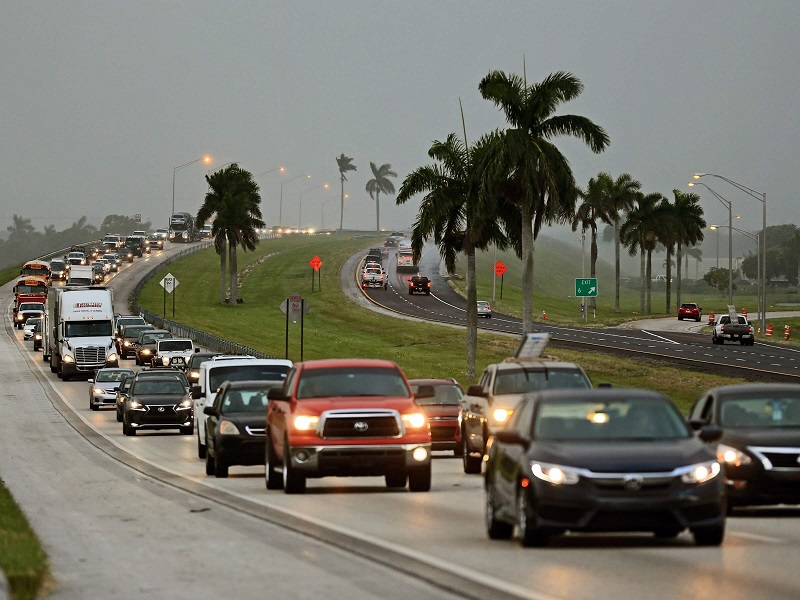An extremely dangerous Hurricane Irma hurtled toward Cuba and the Bahamas on Friday after leaving a trail of devastation in the Caribbean, while an anxious South Florida and Miami prepared for what could be a major hit by the weekend.
Irma, downgraded to Category 4 storm with sustained winds of 150 mph, slammed the Turks and Caicos archipelago early Friday before its powerful core headed between northern Cuba and central Bahamas.
Advertisement
At least 18 people were killed this week as Irma pummeled northern Caribbean islands such as Barbuda and the Virgin Islands. In Puerto Rico, hundreds of thousands of people — nearly 70% of the US territory’s utility customers — were left without power, the governor’s office said.
Irma is expected be near South Florida by Saturday night or early Sunday as at least a Category 4 hurricane, and residents there have begun a mass exodus. Some counties are under evacuation orders, but “all Floridians should be prepared to evacuate soon,” Gov. Rick Scott said Friday.
“Today is the day to do the right thing for your family. Get inland for safety,” Scott said at a news conference.
At its peak, Irma sustained maximum wind speeds of 185 mph, making it one of the strongest Atlantic storms on record. The Red Cross estimates 1.2 million people have already been battered by the storm and warned it poses a threat to millions more.
Advertisement
Here are the latest developments
— Around 11 a.m. ET, Irma’s center was about 270 miles east of Caibarien, Cuba, moving west-northwest with maximum sustained winds of 150 mph. Hurricane-force winds could be felt as far as 70 miles from the center.
— Irma’s bands whipped the Turks and Caicos and the southeastern Bahamas overnight, and is forecast to move between the north coast of Cuba and the central Bahamas through Saturday.
— Irma led to at least 18 deaths in the Caribbean, including nine in French territories, one at the British overseas territory of Anguilla, one on Barbuda, four on the US Virgin Islands, and three in Puerto Rico. Officials didn’t specify which French Caribbean territories had nine deaths but earlier indicated some had been on the island of St. Martin.
— An unspecified number of deaths also have been reported on the British Virgin Islands, Gov. Gus Jaspert said. “Roads are impassable, and there is currently no access to some areas,” Jaspert said.
— The three deaths in Puerto Rico were at least loosely linked to Irma. One person died from a fall while being taken to a shelter; another was killed in a car crash; a third died of electrocution, the governor said.
Advertisement
— Hurricane warnings are in effect for parts of central Cuba, the Turks and Caicos Islands, and the southeastern, central and northwestern Bahamas. Hurricane warnings also are in effect for South Florida, from Jupiter Inlet on the east coast, southward around the Florida Peninsula to Bonita Beach on the west. The warning includes the Florida Keys, Lake Okeechobee and Florida Bay.
— The Red Cross said as many as 26 million people could be exposed to destructive winds and torrential rain just in the Dominican Republic, Haiti and Cuba.
— Both the French and Dutch portions of the island of St. Martin are suffering looting in the wake of Irma, authorities said.
Irma could overwhelm parts of the Bahamas, a nation of about 390,000, with storm surges of up to 20 feet — well above the islands’ elevation, CNN meteorologist Chad Myers said.
Tourists and hundreds of thousands of residents have also been evacuated from parts of Cuba. Usually busy hotels on the northern coast were empty Friday, CNN’s Patrick Oppmann reported from Caibarien.
Some have been evacuated to bomb shelters built during the Cuban missile crisis of the 1960s.
Advertisement
The National Hurricane Center warned Thursday it had become more likely that Irma would “make landfall in southern Florida as a dangerous major hurricane, and bring life-threatening storm surge and wind impacts to much of the state.”
There could be storm surges up to 12 feet in coastal areas of Florida, which could “inundate so many low-level houses, especially on the Keys,” Myers said.
US and European forecast models predict the eye could strike the Keys and then the Everglades, west of Miami, on Saturday night into Sunday morning.
“It’s not a question of whether Florida is going to be impacted — it’s a question of how bad Florida is going to be impacted,” Federal Emergency Management Agency Administrator Brock Long said Friday, urging people to heed evacuation orders.
Though the core has the most power, Irma is huge, with winds of tropical-storm force extending up to 185 miles from the center. At some point late Saturday into Tuesday, the entire state could see at least hurricane-force gusts of 74 mph and above, CNN’s Myers said.
Irma could cause power outages for weeks in parts of South Florida, Florida Light and Power Co. said. “Our crews will likely have to rebuild parts of the system,” the utility said.
Evacuees stocked up on supplies, waited for hours at gas stations and sat through massive traffic jams.
People also flocked to South Florida airports, but schedules were in flux. More than half of Friday’s flights were canceled at Miami International Airport, and “most of the airlines will suspend flights after (Friday) through Monday, depending on the condition of the airport,” spokesman Greg Chin said.
Florida is not the only state preparing for possible impact. Long, the FEMA administrator, said people from Alabama to North Carolina should watch the storm.
Georgia’s Gov. Nathan Deal declared a state of emergency for 30 counties and has ordered evacuations for coastal areas east of Interstate 95, including Savannah, starting Saturday. The governors of North and South Carolina also declared states of emergency.
CNN



